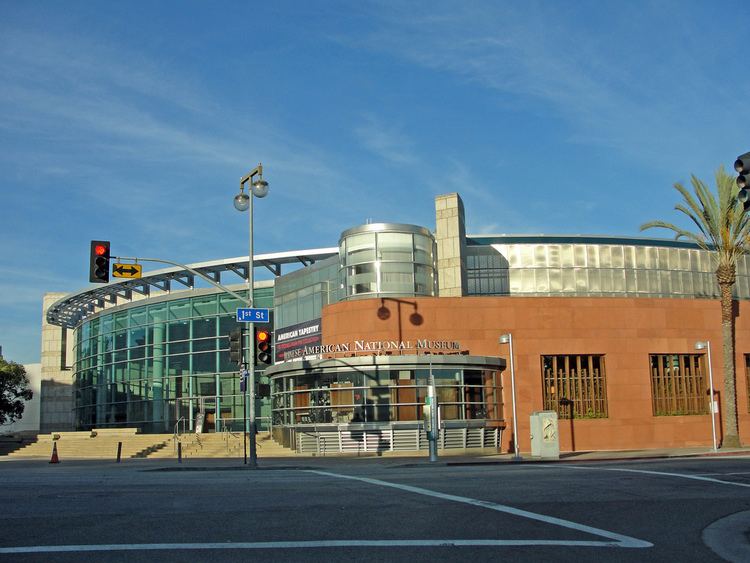Established 1992 Phone +1 213-625-0414 Parent organization Smithsonian Institution | Website www.janm.org Founded 1992 | |
 | ||
Public transit access Little Tokyo/Arts District (Regional Connector) (future) Address 100 N Central Ave, Los Angeles, CA 90012, USA Hours Open today · 12–8PMThursday12–8PMFriday11AM–5PMSaturday11AM–5PMSunday11AM–5PMMondayClosedTuesday11AM–5PMWednesday11AM–5PM CEO Greg Kimura (20 Jan 2012–) Similar Skirball Cultural Center, Densho: The Japanese, Visual Communications, Petersen Automotive Museum, Japanese American Museum Profiles | ||
Japanese american national museum student visits in 2015 2016
The Japanese American National Museum (全米日系人博物館, Zenbei Nikkeijin Hakubutsukan) is a museum dedicated to preserving the history and culture of Japanese Americans. It is located in the Little Tokyo area near downtown Los Angeles, California. The museum is an affiliate within the Smithsonian Affiliations program.
Contents
- Japanese american national museum student visits in 2015 2016
- Japanese american national museum los angeles ca travel thru history
- History
- Exhibits
- Selected previous exhibitions
- Major projects
- References
The museum contains over 130 years of Japanese American history, dating back to the first Issei generation. It houses a moving image archive, which contains over 100,000 feet (30,000 m) of 16 mm and 8 mm home movies of Japanese Americans from the 1920s to the 1950s. It also contains artifacts, textiles, art, photographs, and oral histories of Japanese Americans. The Japanese American National Museum of Los Angeles and the Academy Film Archive collaborate to care for and provide access to home movies that document the Japanese American experience. Established in 1992, the JANM Collection at the Academy Film Archive currently contains over 250 home movies and continues to grow.
Japanese american national museum los angeles ca travel thru history
History
The idea for the museum was originally thought up by Bruce Kaji with help from other notable Japanese American people at the time. When it first opened in 1992, the museum was housed in the 1925 historic Hompa Hongwanji Buddhist Temple building and Irene Hirano served as its first executive director. Then in January 1999, the National Museum opened its current 85,000-square-foot (7,900 m2) Pavilion to the public. The temple building, used in 1942 to process Japanese Americans for wartime confinement, is now used for offices and storage.
In 1993 the museum was given hundreds of artifacts and letters from children in internment camps which they had sent to San Diego librarian Clara Breed. The material was featured in an exhibit, "Dear Miss Breed: Letters from camp" and became part of the museum's permanent collection.
In 1997, the Frank H. Watase Media Arts Center was established by Robert A. Nakamura and Karen L. Ishizuka, to develop new ways to document, preserve and make known the experience of Americans of Japanese Ancestry. In 1999, the Manabi and Sumi Hirasaki National Resource Center (HNRC) was established to provide access to the museum's information and resources, both at the facility and online, and documents both the life and culture of the Japanese Americans.
Akemi Kikumura Yano, author and the museum's first curator, succeeded Irene Hirano as President and CEO from 2008 until 2011. During her tenure, on December 2010, the museum was awarded the National Medal for Museum and Library Service.
Between 2012 and 2016, Episcopal Rev. Greg Kimura was appointed the CEO of the museum. During his time the museum had an economic downturn as he looked to promote untraditional exhibits and let go core staff members. In 2016, Ann Burroughs was announced to replace him as the new interrum CEO.
Actor George Takei serves as a member of its board of trustees and represented it as his charity during his time on The Celebrity Apprentice and during his appearance on The Newlywed Game.
Exhibits
The museum's current ongoing exhibition is "Common Ground: The Heart of Community," covering 130 years of Japanese American history, from the Issei and early immigration into the United States, World War II incarceration, to the present.
Selected previous exhibitions
Major projects
Discover Nikkei A multilingual, online resource that presents the global Nikkei experience through first-person narratives, historic photos and research, and opportunities for user engagement.
The museum's International Nikkei Research Project created the book New Worlds, New Lives.
